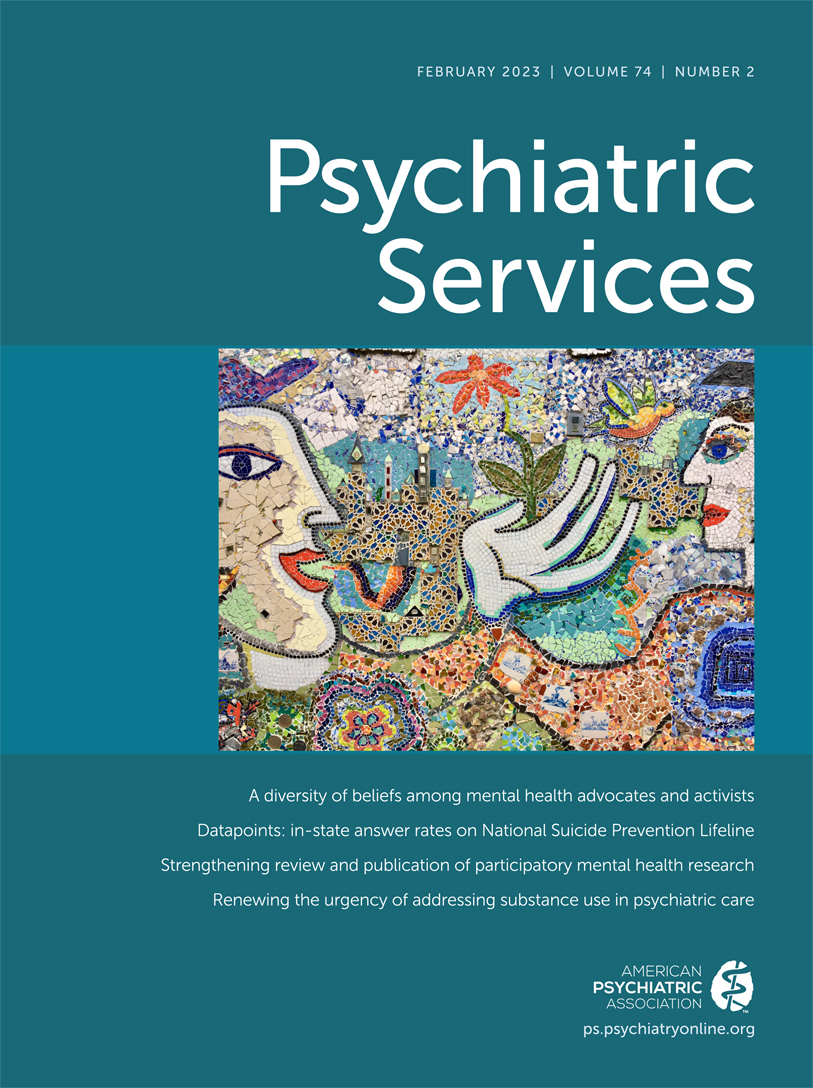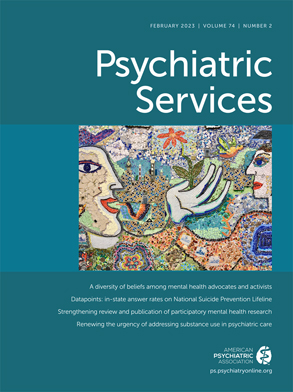Lesbian, gay, and bisexual (LGB) adults are at increased risk of suicide mortality and associated behaviors (e.g., thoughts of suicide, suicide attempts) compared with heterosexual adults (
1), a finding often attributed to minority stress (
2). Thinking of one’s own suicide, planning for one’s own suicide, and attempting suicide are more widespread among LGB adults, across gender, age, and racial-ethnic groups, compared with heterosexual adults (
3). Evidence-based strategies are needed to mitigate suicide risk among LGB populations in an affirming way.
Mental health care settings provide one opportunity to screen and identify those who may be thinking of suicide and to offer evidence-based approaches to manage suicide risk. Approximately half of those who die by suicide had received mental health services in the year prior to their death (
4). Unfortunately, despite rising rates of suicide attempts among U.S. adults since 2008, the rate of mental health utilization among individuals with a suicide attempt has remained static (
5). Currently, the question whether LGB adults at risk for suicide access mental health services at rates comparable to those of heterosexual adults remains unanswered.
At a population level, LGB adults have higher rates of mental health treatment use compared with heterosexual adults (
6); however, prior studies have not always accounted for the higher prevalence of mental health conditions, including suicide risk, among LGB individuals. There may be reason to hypothesize that, depending on the severity of the need, LGB adults tend not to access mental health care, because LGB individuals also have reported high rates of unmet treatment needs (
7), as well as experiences of discrimination in health care settings and distrust of the fields of psychology and psychiatry (
8).
The purpose of the present study was to examine differences in past-year mental health service utilization, type of mental health care received, and perceived barriers to care among LGB and heterosexual adults with a recent reported suicide attempt. By focusing on adults with a recent suicide attempt, we were able to directly assess differences in treatment use among those with demonstrated treatment need as well as with differing sexual identities. This study was intended to illuminate potential disparities in mental health treatment among individuals at risk for suicide and to inform efforts to improve health equity.
Methods
The National Survey on Drug Use and Health (NSDUH) (
9) is an annual representative survey of the civilian, noninstitutionalized population of the United States. Respondents provide informed consent and are interviewed in person with computer-assisted technology; participants are remunerated $30. Data for the current study were pooled from 2015, when the question about sexual identity was first posed in the NSDUH, to 2019. During this period, the annual sample size ranged from 56,136 to 57,146; response rates ranged from 65% to 70%. The current analyses were restricted to those ages 18–64 and those with nonmissing sexual identity data (<2% were excluded because they responded “don’t know” or skipped the question). The total analytic sample size was 191,954, of whom 14,693 identified as LGB. This study was deemed “not human subjects research” by the RAND Corporation’s institutional review board, because it involved secondary analyses of deidentified data.
Sexual identity was assessed on the NSDUH by asking, “Which one of the following do you consider yourself to be?” Responses included “heterosexual, that is, straight”; “lesbian” (if sex was reported as female) or “gay” (if sex was reported as male); “bisexual”; and “don’t know.” Respondents were classified as heterosexual or LGB (i.e., lesbian, gay, or bisexual). Suicide attempts were assessed by asking, “During the past 12 months, did you try to kill yourself?” Past-year mental health service use was assessed via items asking about past-year inpatient mental health treatment, outpatient mental health treatment, and pharmacotherapy for mental health conditions; responses from these three items were aggregated into an indicator for “any past-year mental health treatment.” Unmet need for treatment was measured as individuals reporting a need for, but no receipt of, mental health treatment (“During the past 12 months, was there any time when you needed mental health treatment or counseling for yourself but didn’t get it?”). Those with unmet need could select from various reasons, consisting of those related to cost; fear of being committed or forced to take medicine; not knowing where to go; thinking they could handle problems without treatment; time constraints; concern about confidentiality, opinions of neighbors, or negative effects on job (three items); insurance coverage (two items); thinking treatment would not help; transportation or other access concerns; not wanting others to find out they needed treatment; and not thinking treatment was needed.
Sociodemographic variables included respondents’ self-reported age (categorized in the NSDUH as 18–25, 26–34, and 35–64 years), race-ethnicity (classified into four categories: non-Hispanic White, non-Hispanic Black, Hispanic, and non-Hispanic other race/multiracial [includes American Indian, Alaska Native, Native Hawaiian or Pacific Islander, Asian, and multiracial]), sex (assessed in the NSDUH as male or female on the basis of interviewer observation or inquiry), education (less than high school, high school, some college or a 2-year college degree, 4-year college degree), employment (full-time, part-time, student, unemployed, other), household income (<$20,000, $20,000–$49,999, $50,000–$74,999, ≥$75,000), health insurance (insured, uninsured), living with children ages <18 years (yes, no), survey year, and urbanicity (large metropolitan, small metropolitan, or nonmetropolitan area).
Analyses were conducted among the subset of adult NSDUH respondents who reported a past-year suicide attempt (N=1,946). Among adults with a suicide attempt, survey-weighted prevalence of mental health service use was calculated by sexual identity (heterosexual vs. LGB). Weighted logistic regression was used to estimate differences in mental health service use by sexual identity, with analyses controlling for sociodemographic covariates. For both heterosexual and LGB adults, predicted marginal means (i.e., average prevalence after the analyses were adjusted for sociodemographic covariates) were estimated by using version 16 of Stata’s “margins” command. Reported barriers to treatment, categorized by sexual identity, were examined among the subset of individuals with no past-year mental health treatment who reported a perceived need for treatment (N=230). Statistical significance of differences between groups was set at p<0.05.
Results
Demographic characteristics of the sample by sex and sexual identity are available elsewhere (
3). Three percent of LGB adults reported having attempted suicide in the past year, compared with 0.5% of heterosexual adults (
Table 1). Among those who reported having attempted suicide, 64% of LGB adults reported having received mental health treatment, compared with 56% of heterosexual adults, a statistically significant difference (odds ratio [OR]=1.38, 95% confidence interval [CI]=1.03–1.84). This difference remained unchanged after the analyses were adjusted for sociodemographic characteristics (OR=1.38, 95% CI=1.00–1.90).
Of LGB adults who attempted suicide during the past year, sociodemographically adjusted results indicated that 30% reported having received inpatient mental health care, 46% reported having received outpatient mental health care, and 53% reported having received psychiatric pharmacotherapy for a mental health concern. These estimates did not significantly differ from those of heterosexual adults (28% for inpatient care, 40% for outpatient care, 48% for psychiatric pharmacotherapy).
Of the 36% (weighted, N=213) of LGB adults who reported a suicide attempt but no mental health treatment in the past year, a minority (35% weighted, N=73) perceived an unmet need for treatment. The top three reasons this group did not access mental health treatment were concern about cost (54% weighted, N=38), fear of being committed or forced to take medication (45% weighted, N=29), or not knowing where to go (44% weighted, N=30). In comparison, of the 44% (weighted, N=610) of heterosexual adults who reported a suicide attempt during the past year but no past-year mental health treatment, 23% (weighted, N=158) perceived an unmet need for treatment. For this group, concern about cost was also the most commonly reported barrier (47% weighted, N=80), although a greater number of heterosexual adults reported not knowing where to go (36% weighted, N=56) than reported fear of being committed or forced to take medication (30% weighted, N=51).
Discussion and Conclusions
Among a nationally representative sample of adults, the prevalence of reported past-year suicide attempts among LGB adults was approximately six times higher than among heterosexual adults (3.0% versus 0.5%), consistent with prior studies demonstrating greater risk of suicidality among individuals in sexual minority groups. Our results indicated that, among individuals who reported a past-year suicide attempt, more than half of heterosexual adults and almost two-thirds of LGB adults reported having received any mental health treatment in the past year, representing significant treatment gaps for both groups. Both the elevated prevalence of suicidality and of treatment seeking among LGB adults underscore the need for proficiency of clinicians and health systems in providing affirming, evidence-based mental health treatment to at-risk patients in order to identify and manage suicide risk. Training is available to mental health care providers to improve competencies in identifying and managing suicidality (e.g.,
https://cams-care.com) (
10). Similarly, the Substance Abuse and Mental Health Services Administration provides a compendium of training curricula to promote affirming care for lesbian, gay, bisexual, transgender, queer, or questioning (LGBTQ+) patients (
11), which may help compensate for the lack of LGBTQ+-specific programs in U.S. mental health facilities (
12). Overall, continued policy efforts are needed to improve access to and uptake of mental health services among those at risk for suicide.
Barriers to care can be attributed to a broad range of causes (
13). Top barriers to care among the current sample, for both heterosexual and LGB adults who perceived a need for care, were affordability (i.e., concern about cost), approachability (i.e., concern about being committed or forced to take medications), and availability (i.e., not knowing where to access care). These concerns suggest the importance of continued initiatives to promote affordable and patient-centered mental health care. Additionally, ongoing efforts to destigmatize mental health treatment among all adults are needed. LGB adults may also experience unique treatment barriers not assessed by the NSDUH, including concerns about sexual identity disclosure and challenges in finding an LGB-affirming provider.
This study had some important limitations. First, NSDUH measures are cross-sectional; thus, we could not establish temporal ordering of suicide attempt and treatment use. Access to evidence-based care is imperative both for those at risk for a suicide attempt and for those with a recent suicide attempt. Because a past suicide attempt is a strong predictor of a future suicide attempt (
14), specialized care may be warranted for individuals with a recent suicide attempt. Because of sample-size limitations, we analyzed differences only between heterosexual and LGB adults; we were unable to examine differences between gay or lesbian and bisexual adults. Additional measurements were limited because the NSDUH assesses sex via interviewer observation (rather than self-report), does not assess sexual identity among adolescents, does not assess perceived discrimination as a barrier to care, and does not assess gender identity. Future research is needed to characterize mental health service use among youths identifying as belonging to sexual minority groups and individuals with past suicide attempts who identify as belonging to gender minority groups. Data on suicide attempts and health care use were collected via self-report, and may have been biased, but this method is commonly used to collect data such as these in population-based surveys.
Overall, the LGB adults in our sample experienced pronounced risk for suicidality compared with their heterosexual peers. Encouragingly, our findings indicated that, among adults with a recent suicide attempt, LGB adults were not systematically less likely (and indeed were 1.4 times more likely) to receive treatment, compared with their heterosexual peers. However, reducing the disproportionate burden of suicidality among LGB individuals will require ensuring access to evidence-based and affirming care while simultaneously addressing the high unmet treatment need among all individuals at risk for suicide.

